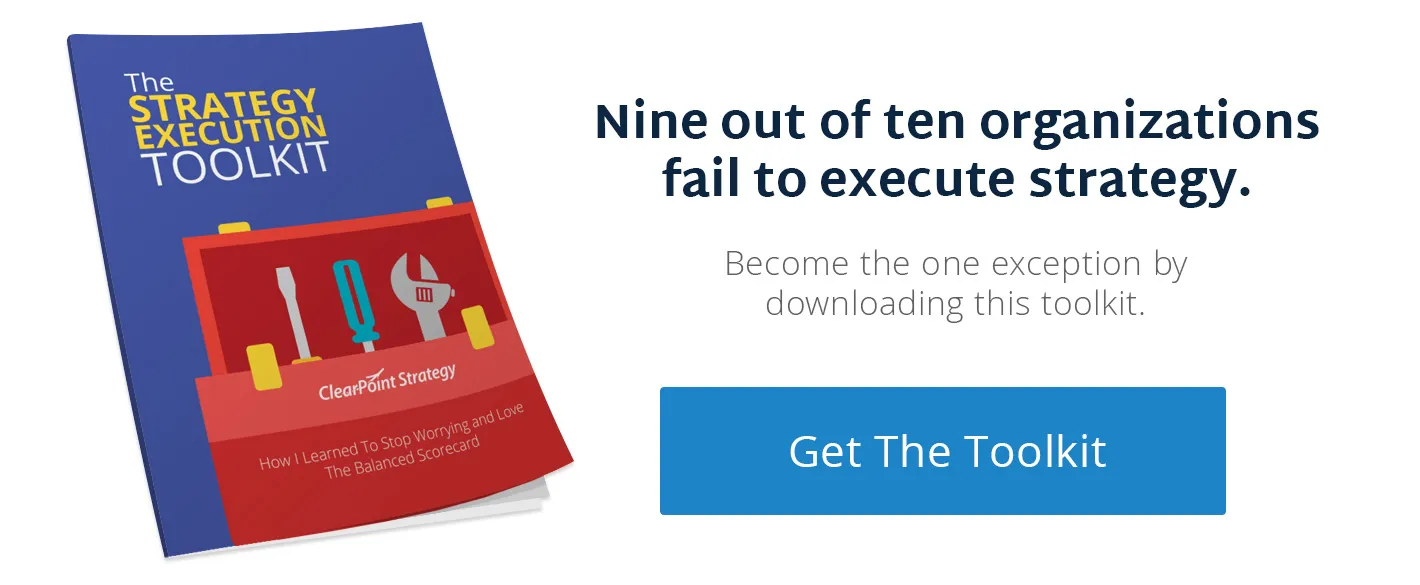Strategic VS. Operational Planning: The 7 Main Differences
.webp)
Uncover the 7 key differences between strategic and operational planning, how each impacts your business and guides you in aligning them for success.
Strategic planning and operational planning are both vital to an organization's success. Oftentimes, organizations use both terms to mean the same thing, but they shouldn't.
Are they the same? If not, what’s the difference? Do you need both? We hear these kinds of questions frequently. To help answer them, first we'll walk through the definitions of strategic planning vs. operational planning. Then, we'll explain the main differences between them.
What is a strategic plan?
A strategic plan outlines your mission, vision, and high-level goals for the next three to five years. It also takes into account how you’ll measure those goals, and the major projects you’ll take on to meet them.
What is an operational plan?
An operational plan (also known as a work plan) is a highly detailed outline of what your department will focus on for the near future—usually the upcoming year. The plan will answer questions - who, what, when, and how much - regarding daily or weekly tasks.
.webp)
Simply put, your strategic plan shares your vision for the future, while your operational plan lays out how you’ll get there on a daily to weekly basis.
Both concepts describe your company's plans for the future, but in different contexts.
Strategic & Operational Planning Examples
Take Meta, for example (formerly Facebook). The company recently announced that an important part of its strategy will be building a new computing platform called a metaverse—a shared virtual world environment. This is a long-term goal that leader Mark Zuckerberg says is “critical to [the company’s] mission.” The creation of this new metaverse would be considered part of the company’s strategic plan.
To accomplish that goal, Meta needs to derive an operational plan outlining tasks that need to be done. Numerous components are involved in creating such a platform—everything from creating standards and protocols for the virtual world to developing the necessary hardware and software to determining how to monetize the experience, and much, much more. Meta has to detail which specific activities its people need to do in each area and when they’ll need to do them. This operational plan will ensure they meet certain milestones and that the company continues moving in the right direction over the long term.
A simpler strategic and operational planning example: Say you have a strategic plan modeled after the Balanced Scorecard. It names the high-level goals your organization is trying to accomplish in each of the four perspectives. It also includes aligned and linked measures and projects designed to help you achieve your objectives. Based on that strategic plan, each department in your company will then need to develop an operational plan for the projects they are responsible for to determine how the work will get done. Completing those projects will help you stay on track to accomplish your goals.
Strategic Planning Vs. Operational Planning: 7 Differences
To clarify the concepts of strategic vs. operational—and help you put them into practice—take a look at seven of the most significant differences between the two ideas:
1. Time Period
Your strategic plan outlines long-term goals for the next three to five years. What you’ll be doing to achieve those goals in the shorter term (typically the next fiscal year) is outlined in your operational plan.
2. Modification
Your strategic plan should be fairly weatherproof, but that doesn’t mean it won’t occasionally require modifications. Evaluate your strategic plan yearly to see if it still makes sense in case of dramatic changes happening inside or outside the organization, for example, or unexpected performance results. It’s also possible that new opportunities (or threats) may have arisen in the past year that require consideration.
In contrast, you should reevaluate your operational plan monthly. While your strategy may be able to handle the unexpected, the path to reaching your long-term goals is somewhat fluid.
3. Goal
The goal of your strategic plan is to outline the company’s long-term vision and how all departments should work together to achieve it. Because goals are company-focused, strategic plans are more broad in scope than operational plans.
The goal of an operational plan applies to specific departments, not the company as a whole. There can be overlap between departments, but that’s the exception rather than the rule. Large departments may require multiple operational plans. Because of its narrower focus, an operational plan is inherently more detailed than a strategic plan—it outlines how you’re going to get it all done!
4. Plan Generation
Your organization’s high-level leadership team—the executive team or city council, for instance—is responsible for creating the strategic plan. Once it’s created, the strategic plan will be pushed forward by cross-functional teams who work together to ensure the strategy is successful.
9 out of 10 organizations fail to execute strategy. Avoid failure with this toolkit.
Every department should have a leader or team of leaders responsible for creating their operational plan. Although each operational plan is designed for a single department, its successful implementation will lead to organization-wide success. For example, your marketing team has a set of activities they use to increase visibility. These activities should translate to more sales opportunities and ultimately more revenue for the organization (which could be goals in your strategic plan).
Having the right people in the room no matter what type of planning you are doing is key. This is especially true if your organization ever needs to adjust their strategic or operational plans because of an unexpected change in the operating environment.
5. Budget
The budget for your strategic plan comes from your strategic budget, not your operational budget. Your organization may implement a Strat-Ex budget that aligns part of your budget directly to your strategic projects or initiatives. This is a different approach than putting a budget against each of your divisions or departments.
The budget for your operational plan comes from your department’s annual budget. If your annual department budget needs to be cut, consider which elements don’t align to your strategic plan and cut those first. For example, if your strategic plan defines a marketing goal of establishing a strong online presence, your trade show budget should receive budget cuts before blog writing does.
6. Reporting
When you report on your strategic plan (typically both annually and quarterly), your strategic planning committee or executive team will want to look at how your company is performing on its chosen measures. Depending on the meeting, these discussions should remain fairly high-level so you don’t get bogged down on details.
Your operational reports, on the other hand, outline hundreds of projects or tasks people in the department are working on. Monthly operational reporting meetings give the leadership—and the rest of the department—an indication of each project’s status.
Unlike your strategic report, updates on operational projects can be anecdotal or qualitative (as it’s often difficult to quantify actions that aren’t tied to measures). Some organizations have a running text commentary either in an Excel field or a Word document. This commentary is updated weekly or monthly, even if there are no direct measures for that part of the operational plan.
7. Focus
Your strategic plan revolves around how your organization can be different. What sets you apart from other organizations is your mission and vision; the goals you set tie into those concepts. Thus, a strategic plan distinguishes your organization’s direction as being different from that of other companies.
In contrast, your operational plan revolves around being better operationally. If you can implement and execute your strategy efficiently and effectively, your chances of successfully reaching your business objectives increase significantly.
Simplify Strategic & Operational Planning With A Single Tool
To be a strategy-focused company, you need both a strategic plan and departmental operational plans. You also need a tool to help manage these aspects.
Notice we said “a” tool—not multiple tools. Many organizations struggle to stay on top of performance in these areas in part because they’re using separate tools that create data silos, making it more difficult to see the big picture, which is simply: Are we on track to reach our long-term goals?
ClearPoint is designed to help your organization track its strategic plan. Our software also has some critical functionality that serves to help you manage your operational plan. ClearPoint is considered the most comprehensive strategy reporting software available on the market because users can:
- Link and align goals to measures and projects to see progress on their strategic plan.
- Track project statuses to see how they impact the strategic plan.
- Set up allstrategic projects to track the same information for purposes of “big-picture” reporting that reveals trends and gaps.
ClearPoint also makes it easy to create and share strategy progress reports—we’ve automated 70% of the reporting process! Whether you (or your cohorts) want a quick glance at progress or a detailed report, you can get the information you need without wasting time or manpower on menial reporting tasks.
Put It Into Practice
If all this sounds like a lot of work, don’t worry—you’re probably already farther along than you think! Most departments have some form of operational work plans in place already. So you shouldn’t need to start from scratch; simply put your current plan into a framework or format that helps you perform at a higher level.
Similarly, if your company doesn’t have a fully fleshed-out strategic plan, we have you covered. By the time you’ve filled out this free toolkit, you’ll have a change agenda ready and a strategy map created—complete with your top-priority goals! Download it below.




.webp)
.webp)
.webp)
.webp)
.webp)
.webp)
.webp)
.webp)
.webp)
.webp)










